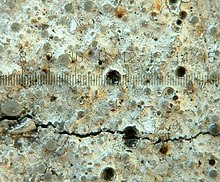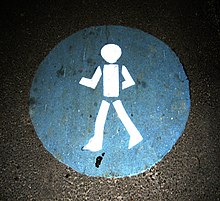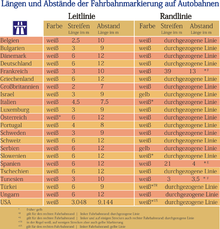Road marking
The road marking , also lane marking or floor marking , is a colored marking on the surface of traffic areas of road traffic . It is part of the road equipment and is used for traffic management , the marking of various traffic areas and as a traffic sign .
Road markings have been used on asphalt or concrete roads since the beginning of the 20th century and have gained in importance due to the sharp increase in road traffic in the post-war years. During this time, different marking symbols were developed and a variety of marking materials and techniques were tested. A number of requirements are placed on road markings in order to ensure durability and road safety.
tasks

Road markings perform a variety of tasks. They enable or improve orientation on traffic areas and create clear and safe traffic routing:
- Line-like markings divide traffic areas and assign them to different traffic flows or directions of travel . Lane markings represent an economical and effective method of directing and influencing traffic and perform their tasks together with the other guidance systems on the road.
- Furthermore, they contribute to road safety in connection with other road users (pedestrian and bicycle traffic, rail traffic). Systems for stationary traffic ( parking areas ) are clearly separated from flowing traffic with lane markings. Road traffic structures (such as traffic islands ) can be identified in this way.
- In addition to guiding the traffic, the lane marking can warn road users of dangers or provide instructions for directional guidance .
The color of the marking contrasts with the color of the roadway and thus ensures that road users are visually guided by day and night. Special compositions of the marking materials enable sufficient visibility in poor visibility (wet roadway, tunnel sections and the like). The application of temporary markings in the construction site area is of great importance , as this ensures a safe flow of traffic in cramped conditions.
In urban areas there is the possibility of doing without markings in order to reduce speed and to protect the cityscape. The prerequisite for this, however, is that the traffic is guided and regulated by other measures and does not exceed a certain traffic volume (around 1200 vehicles per hour).
history
Edward N. Hines (1870–1938), a member of the Wayne County Roads Commission in Michigan , suggested in 1911 that white lines be drawn along the center of each bridge and curve in his district. This concept was later extended to the entire length of the street. Hines is considered to be the first person to put the concept of road marking into practice. As early as 1883, John Macnie, a professor at the University of South Dakota, predicted that automobiles would travel at 25 miles per hour in the future . The roads required for this would then have to be divided in the middle by a white line in order to keep the traffic on the correct side. Macnie's considerations also envisaged three-lane lanes near cities, with heavy traffic having to stay in the outer lane.
In 1918, the streets of larger cities in Germany are said to have been marked with white lines. In 1921, Great Britain's first road markings were made in the small English town of Sutton Coldfield , a suburb of Birmingham . This experiment to defuse a hotspot at the time was so successful that white lane markings became the standard in Great Britain and other countries. The increase in traffic density and the speed of motorized traffic brought further impetus to the application of road markings. In 1925, for example, white markings for lane and lane delimitation were officially introduced in Berlin . The first regular Germany-wide use of markings took place as so-called embankment markings from 1932 and mainly served as paint for curbs . The first center line markings on the Reichsautobahn were made in 1932. These were initially applied in black in order to achieve a good contrast to the light-colored concrete surface of the roadway. From 1935 the continuous center line became an integral part of the Reichsautobahn . The decree of August 6, 1936 included the provisional equipping of the Reichsautobahn. In some cases, arrows and corresponding lines have already been drawn onto the road at exits. With the provisional instructions issued in 1938 for the implementation of construction work on the Reichsautobahn, No. 10 , the marking rules were further specified. The dividing lines between the lanes were now drawn in white. In addition to the already known markings for the middle of the lane, the edge of the lane has now also been provided with a solid white line.
In November 1938, an amendment to the new German Road Traffic Regulations (StVO), which came into effect in the same year, came into force, in which lane marking was included in the set of rules for the first time. This was a stop line running transversely to the roadway, which was to be placed in side streets in front of pedestrian crossings and was in connection with the stop sign that was also introduced. Two dashed lines running along the road and reaching a depth of 10 meters before the stop line in the side road were intended to encourage drivers to brake. From 1939 onwards, the Reichsstraßen were marked for the first time with a continuous dividing line that divided the street into two lanes. The solid center line did not have the current meaning that prohibits overtaking, but was only intended to separate the lanes from each other. The markings on the lanes, which were mostly very local until the construction of the autobahn, were mostly applied by hand using lane markers . This costly manual system no longer made sense when marking motorways at the latest. The first devices for uniform marking, which had to be pushed by hand, were now used. The development of durable pavement markings was making great strides at this time. In Germany, for example, there was a patent issued in 1943 for the production of friction-resistant road markings from paint and synthetic resin compounds, using plasticizers or other additives such as roughing material. Catalysts added to or subsequently applied to the mixture should serve for the final hardening, hydrochloric acid preferably being used.
After the Federal Republic of Germany was founded in 1949 and due to the now rapidly increasing motorization, the use of lane markings to improve traffic management was intensified. This development took place in parallel in most of the Western European countries. In the Federal Republic of Germany, the first general road edge marking was carried out for the first time in 1952. In the German amendment to the road traffic regulations that came into force on September 1, 1953, additional road markings are introduced. This included the stop line, which now worked independently of pedestrian crossings that were given their own markings. In addition, for the first time, dashed dividing markings for the lanes as well as painted white arrows and the zebra crossing have now been included in the regulations. The publication of the "Instructions for the arrangement and execution of lane markings on federal highways (HMB)" by the German Federal Ministry of Transport, which were created on the basis of preliminary work by the Research Society for Roads , opened the way to a comprehensive marking system in 1954. In 1956, the leaflet for the arrangement of lane markings on city streets (FASt) was added , which had also been drawn up by the Research Association for Roads. In the meantime, a wide variety of machine types were in use, which increasingly automated the application of the markings. The driver now sat astride a motorized vehicle and steered the steering wheel along a route marked with chalk. From the 1950s onwards, thermoplastic markings became increasingly popular and increasingly replaced the simple color systems that had been used until then. After the StVO amendment of April 30, 1964, a statutory parking ban - for example at bus stops - could now be extended or restricted by means of zigzag lines. The first new road traffic regulations after 1938, which came into force in 1971, introduced lined restricted areas for traffic for the first time with sign 298. In the amendment that came into effect in 1992, the advance notice arrow positioned on the center line became part of the StVO. In the early 1970s, the first cold spray plastic markings were applied; the advent of cold milling made it possible to insert markings. In 1984 the type II marking was developed and used for the first time on the A 49 . This was the first time that a marking system was used that guarantees increased night visibility when wet. Marking materials such as emulsion paints , foils or cold plastics were first applied in the 1990s with a view to durability and environmental protection.
application
The application of the marking on the roadway using the roadway marker is called application . The application can essentially be carried out with five techniques:
- Spraying process
- Procedure with a puller shoe
- Extrusion process
- Stick-on or roll-up method
- Coating process
Before the actual marking can be applied, a so-called pre-marking is used. According to the specifications of the marking plan , a nylon cord is placed and pre-marked with silver bronze along this nylon cord. Silver bronze is not very durable and disappears from the road surface after a few months.
After pre-marking, different steps can follow depending on the marking process. For example, if an inserted marking is applied, recesses must be milled into the road surface . If the marking is applied, there is no milling work. Then, with the help of a marking machine, the road marking is sprayed on , extruded or applied using a pulling shoe . Finally, to increase night visibility and grip , it may be necessary to sprinkle the freshly applied marking.
Symbols and pictograms are either created using templates or templates, or they can be rolled up or glued on as a whole. To mark an area, the marking material is spread by hand on a specified area.
In order to obtain permanent and optically perfect marking, the road surface must be clean and dry. Unsuitable substrates or old markings must be removed to such an extent that proper application is possible. In addition, it is important to ensure that the weather is suitable. Cold and wet weather causes the marking work to be inadequate. Certain substrates and marking materials require priming in order to establish a permanent bond. After the marking work has been completed, there is a sufficient time to wait before traffic will run over the marking. If this is not observed, the marking, which has not yet dried, will be eroded and deformed.
Various demarking techniques are available to remove existing marking characters . The covering of areas to be demarcated with dark color or dark film is not permitted, but is used in many places. Instead, the marking can be milled off or removed using a high-pressure water jet. If a marking foil needs to be removed, it can either be scraped off or removed with a flaming device. The guidelines stipulate that the marking signs must no longer be recognizable to road users after they have been removed.
A line width stabilizer automatically keeps line width changes within small limits during path-dependent airless spraying. The amount of paint delivered by the pump is proportional to the driving speed of the machine. As the speed increases, the amount of paint pushed through the spray nozzle per unit of time increases, which is accompanied by an increase in pressure in the paint line to the nozzle. It is known that an increase in the spray pressure results in an increase in the spray angle. If the distance between the pistol and the road surface remains unchanged, the line width increases. This effect depends on the nozzle and color used. The change in the line width can, however, be kept within small limits in a large speed range by means of a line width stabilizer.
- Application techniques
properties
Types
In terms of lane markings, a distinction is made between type I and type II markings . Type I markings are conventional markings and were state of the art well into the 1980s. They are sprinkled with retroreflective glass beads , so-called reflective beads , and grip agents . The behavior of the type I marking on wet roads is problematic. In this case, a film of water forms on the roadway and marking, which greatly reduces retroreflection and thus overrides night visibility, which means that the marking is no longer effective and road users are more difficult to find their way around. For these reasons the Type II marking was developed.
Type II markings are markings with increased night visibility when wet. They have largely replaced the conventional Type I markings. On German roads around 70% of the markings are type II, on trunk roads almost all type I markings have been removed. Due to the better recognizability of the marking in wet and dark conditions, the guidelines advise to use type II marking preferentially. The functioning of the Type II marking is characterized by protruding several millimeters from the water film on the roadway. The effect of the reflective pearls when wet is retained in this case.
Type II markings can be divided into three systems:

1. Smooth line markings with coarse sprinkling agents
Reflective pearls are added to the marking material during production, so there is no need to sprinkle it after application. The advantage of this system is that there are also reflective beads below the marking surface and that they take effect as the abrasion progresses. Conventionally scattered systems lose their retroreflective properties as the surface wears.
2. Profiled markings with haptic and acoustic warning effects
Markings of this system are given a strong profile on the surface. For example, webs can be applied along or across the direction of travel. The webs stand out particularly far from the roadway and generate a haptic and acoustic warning effect when the vehicle drives over them. The vehicle driver becomes aware of the dangerous situation and can intervene. They should therefore be used especially for edge markings. However, the noise development can be perceived as annoying by residents. Another disadvantage is the high level of wear and tear on the marking when the snow plow is used frequently .
3. Markings with stochastically distributed agglomerates
Agglomerates are markings that are composed of unequal size components and thus result in an uneven surface. The marking substance is therefore not applied over the entire surface. The surface can be composed of regularly or irregularly applied agglomerates. There is no need to add additional, particularly large reflective beads due to the high layer thickness. In addition, this marking provides higher grip values (see also: SRT measurement ). Like all Type II markings, it protrudes from the water film of the roadway and is relatively resistant to frequent use of snow plows.
If this marking is viewed from a distance of 30 meters, the driver perceives it as a full line. However, it should be noted that when the sun is flat and there is corresponding backlighting, the marking can be difficult to see during the day. The design of this marking enables rainwater to flow through the marking towards the edge of the road. The lines must have a clearly recognizable border.
materials
Various marking materials have been developed over the years. Their suitability must be proven at a competent approval and testing institute (in Germany, for example, the BASt ). Basically, the following materials can be distinguished:
The road markings are made from different materials depending on the application. Simple markings that are rarely run over are made of plastic paint. If the durability of the marking is to be increased, hot spray and hot plastic materials are available. It is also possible to apply cold plastic, in which case two components are mixed on site. Marking foils can be used for temporary marking tasks.
So-called marker buttons made of metal are suitable on paved surfaces. They can also be retroreflective or have their own lighting. Please note that marker buttons can only be used up to a speed of 50 km / h. Furthermore, the distances between the marker buttons must be limited.
conditions
Different requirements are placed on road markings in order to ensure the highest possible durability and effectiveness. An exception are markings that are only applied temporarily, such as construction site markings. The color of the marking must stand out particularly well there, day and night visibility must be guaranteed and the marking must be removable without leaving any residue.
The main requirements for permanent road markings are:
- The day and night visibility serves to make the marking signs recognizable in bad weather as well as day and night. To this end, the guidelines call for visibility values that markings must adhere to.
- The grip of markings has a direct effect on road safety and must therefore be sufficient. The grip is measured using an SRT pendulum , the standard specifies corresponding limit values.
- The layer thickness must be limited for reasons of drainage and driving dynamics. The standardized limit values apply to both inserted and applied marking symbols.
- The color location regulates the coloring to be used for the marking.
- The rollover capacity , that carry vehicles, should ideally be given early after application, otherwise the traffic flow is impeded unnecessarily long.
- The wear resistance and durability is required for the durability of marking characters. It depends on whether the marking is seldom, frequently or constantly driven over and the layer thickness of the marking. The guidelines divide them into traffic classes that indicate different levels of exposure. Markings that are applied across the road or are exposed to frequent braking or acceleration are particularly stressed. The use of snow clearing equipment from winter service on marked areas also has a negative effect on durability . The warranty period for road markings in Germany is two years. The shelf life, on the other hand, is very difficult to determine; four to eight years can be assumed as a rough guide.
Colours
Markings in Europe are predominantly white. In Austria until 1996 the road markings for flowing traffic were yellow and only white for stationary traffic. In Switzerland, yellow markings are used for regular public transport and for pedestrian and bicycle traffic. In Norway, USA and Canada the middle mark is yellow.
In construction site areas , yellow (so-called "yellow markings") are applied in Germany, and yellow-orange markings in Austria and Switzerland to show that the regular markings are invalid. In Germany this is regulated by § 39 StVO.
Cycle paths can be marked with a blue or red colored area marking.
In some European countries, yellow markings for parking and stopping bans (e.g. France, Luxembourg, Austria, Switzerland) and blue markings for special parking regulations are common ( blue zone in German-speaking countries, zone bleue / zone verte in France).
Generally it is possible to produce any imaginable color for marking signs. However, due to the lack of contrast to the road surface, not all colors are suitable for marking. In addition, light colors become dirty more quickly than darker ones.
Even before the StVO allowed one-way cycle lanes in Austria, the Graz magistrate marked cycle lanes with a line in green. In addition to a white line as a warning, cycle lanes are also marked in red. In Austria, for example, guidelines were in yellow for a long time, then only in white, as in other countries.
Environmental behavior
Road marking abrasion is responsible for 7% of the primary microplastic in the oceans.
Markers
Road markings consist of different types of marking. The different markings and their dimensions are listed below. The list is based on the “Guidelines for Marking Roads” that apply in Germany, but the international markings often only differ slightly, as can be seen in the adjacent illustration. The markings of other countries can, however, be looked up in the respective applicable road construction guidelines of the countries.
Different line widths are used for the marking signs depending on the road category. The following line widths are defined in the guidelines:
| Highways | Other roads | |
|---|---|---|
| Slash | 0.15 m | 0.12 m |
| Broad line | 0.30 m | 0.25 m |
Longitudinal markings
Longitudinal markings are arranged along the direction of travel and largely take over the visual guidance of the road user. Furthermore, they structure the existing street space.
- The guideline is a broken line and can be driven over by road users. It serves as an orientation line for the vehicle driver and marks his lane beyond the lane boundary. It is applied as a narrow line. Outside of intersections , the ratio of line to gap in Germany is usually 1: 2. In Austria the ratio is 2: 3. The ratio within nodes is 1: 1. The line length depends on the permitted speed. It ranges from 6 meters on motorways to 3 meters on urban roads . In the narrower junction area it can also be 1.5 or 1.0 meters. In urban areas, the guideline is often dispensed with to calm traffic in Switzerland. In Germany this is sign 340 (Annex 3, Section 8, No. 22, to Section 42 (2) StVO).
- A warning line (D) or an advance warning line (CH) is a modification of the guideline and is used to announce obstacles, lane splits or lane delimitations. The gap in Germany is only half as long as the line, in Austria the gap is a quarter as long. The warning line is also designed as a narrow line.
- The lane boundary (D) or the edge line (CH) is a solid line in Germany or Switzerland, and a broken line in France or Sweden and marks the edge of the roadway. Interrupted edge marking is also to be introduced in Germany. It can be designed either as a narrow line or as a wide line. It should be noted that the hard shoulder of a motorway is not part of the roadway and receives no edge marking. In urban areas, lane delimitation markings are largely dispensed with, as there is a curb here .
- The lane delimitation (also known as the blocking line or safety line ) is a continuous line that must not be crossed. It is mainly applied to road sections that are difficult to see. The line can be designed either as a narrow or as a broad line. In Germany this is sign 295.
- A one-sided lane delimitation (combined lane delimitation and guideline, in Switzerland double line ) consists of a lane delimitation line and a guideline parallel to it. It may be crossed from the side of the guideline, but not from the other side.
- The departure line separates the merging lane (formerly an acceleration lane ) of a motorway junction from the continuous lanes. It can be recognized in Germany by wide, 6 meter long strips with a distance of 6 meters each, on country roads it is 3 meter long strips with a distance of 3 meters. In Austria there are 4-meter-long strips with a distance of 2 meters on motorways and 2-meter-long strips with a distance of one meter on country roads.
- The double lane delimitation (in Switzerland double safety line , colloquially double line ) consists of two solid parallel lines that must not be overlooked by any part of the vehicle. The two lines can also be interrupted. Then the line may be crossed on instruction (for example in direction change operation ).
Area markings

This type of road markings are applied over the entire surface of the road. Restricted areas are used to mark traffic areas that are to be kept clear of vehicles. On traffic areas for cycling are thought to bike path markings are used.
- The slash gate (in Switzerland and Austria, in the German road traffic regulations and the associated administrative regulation restricted area ) is used to display areas that are not allowed to be driven over by motor vehicles. Its area of application is predominantly in the intersection area. A distinction is made between the small and the normal slash gate. The normal slash gate is applied out of town and consists of slashes which are bordered by a border line. The small slash gate with narrower bars and less spacing is used in inner-city areas.
- The cyclists ford in Germany consists of a broken or solid border marker in white color, in Switzerland there is a bicycle lane from a broken line. In Germany as well as in Switzerland, area marking, mostly in red, is also applied, especially in the intersection area. To make things clearer in the intersection area, the “Bicycle” pictogram can also be applied in white.
Boundary markings
In blue zones , the colored road marking (red and blue) or the absence of a marking determines the do's and don'ts for stopping or parking.
Border markings in Germany
In order to further clarify or extend existing stopping bans , so-called border markings for stopping and parking bans (also zigzag lines ) can be applied to the roadway in Germany . A distinction is made between interrupted and continuous zigzag lines. According to the StVO, limit markings are only permitted in N-shape. The X-shaped design requires approval by the respective highest state authority, even if it is listed in the guideline for road marking (RMS). Broken lines are often used at bus stops; the word “BUS” is also applied within the border marking. The road traffic regulations prohibit parking on these marked lane areas.
- The zigzag line has a line width of 0.12 meters. The oblique lines are drawn at a 45 ° angle.
- The interrupted zigzag line is a modification of the border marking mentioned above and is used at public transport stops. The word "BUS" is located within the interrupted border marking. The line widths and aspect ratios resemble the continuous zigzag line.
- Boundary markings in N- or X-shape mark short stretches of road on which stopping and parking is prohibited.
Border markings in Switzerland
In Switzerland, areas where parking or parking are prohibited are marked in yellow. No parking is indicated by a no- parking line or a no- parking area; the no- parking line is used to indicate a no- parking zone . Zigzag lines mark public transport stops. People may stop at such places to allow people to get on and off, provided that vehicles are not obstructed in public service ( Art. 79 Para. 3 SSV).
Cross markings
Crossing pedestrian or cycle roads (formerly known as cyclists' roads) or stop or waiting lines are applied across the direction of travel , only in the intersection area or at crossing points. The pedestrian crossing is also one of the cross-markings. This type of marker is particularly often run over and should therefore be inserted.
- Stop lines (in Switzerland holding lines ) must be placed where the traffic has to stop. The stop line is a continuous horizontal line with a line width of 0.5 meters. In addition to the stop line, it is planned in Switzerland to put the word “Stop” on the carriageway. A stop line must be applied at the following points:
- Waiting lines (in Austria: order lines ) Section 15 delimit areas on the roadway that are intended as a set-up area for turning maneuvers. The broken line marking is 0.5 meters wide and consists of 0.5 meter long broken lines with 0.25 meter long gaps. In Switzerland, the waiting line consists of a series of white triangles across the road. These so-called shark teeth are optionally also provided in Austria (Section 15, Paragraph 3) . They have also been in place in Germany since April 28, 2020, to show the right of way for cyclists at appropriately signposted intersections and cycle superhighways.
- A pedestrian crossing or cycle paths ford , or cyclists crossing in Austria is characterized by a discontinuous cross-line with short dashes. In the case of the cycle path ford, the line is made wider. Pedestrian crossings have at traffic signals are marked. In addition, they may only be marked on crossings that are secured by school guides, school helpers or other traffic aids. In addition to traffic lights, cycle paths must be marked on priority roads with cycle paths or footpaths open to cycle traffic. As a longitudinal marking, they indicate the right of way for cyclists compared to vehicles turning, entering and crossing. Fords are unknown in Switzerland, where pedestrian crossings are used.
- The pedestrian crossing (in Germany pedestrian crossing , also zebra crossing , in Austria protective path , in Switzerland pedestrian crossing ) consists of marking strips arranged parallel to the direction of travel. The eye-catching display makes vehicle drivers aware of the crossing pedestrians.
Parking area markings
These types of markings regulate the arrangement of parking areas and their demarcation from flowing traffic. The lines indicate the manner in which and on which land vehicles set up are. If the traffic area for pedestrians is not restricted, parking area markings can also be carried out on the sidewalk. The lines are applied as a narrow line and can be displayed both continuously and interrupted. However, at least the four corners of the individual parking area must be recognizable.
The lines are applied in white; in deviation from this regulation, blue lines indicate short-term parking spaces or short-term parking zones in Austria and Switzerland . In the inner city of Munich , different parking regulations are represented by different colors under such blue zones .
In some European countries (e.g. Great Britain, France or Luxembourg) a solid or dashed, yellow or red, single or double marking of the curb is also used to indicate parking or stopping bans. From 1963 to 1979, Switzerland also knew such color stamps or stripes.
Parking area marking for lengthways installation
Parking area marking for vertical installation
Arrows
Arrows on the lane are used to indicate the direction and direct traffic both on the open road and in the intersection area. A distinction is made between direction arrows and advance notice arrows , both of which are to be marked over the entire area.
- Directional arrows are attached to lanes at junctions and enable road users to orient themselves at an early stage and to select the desired direction of travel. Parking is prohibited on sections of the route that are marked with arrows. The direction arrows point to the end of the lane and are repeated three times. A smaller version can also be used on bike paths. In Switzerland, yellow directional arrows are used for public transport.
- Advance notice arrows indicate the end of a lane or announce a lane delimitation. They are in the axis of the warning line and are repeated three times.
special character
Special characters in Germany
Special signs are placed on the roadway to clarify the traffic flow and traffic management. Numbers, traffic signs, pictograms and letters are used. In order to ensure recognizability by the road user, the special characters must be distorted three times in length. According to the road traffic regulations ( § 39 Paragraph 7 and 8 StVO), a special sign or lettering on the road indicates a corresponding traffic sign; it is not permitted to use it alone. The pictograms and characters must comply with the requirements of the road traffic regulations and the marking guideline, the application of imaginary signs is therefore not permitted. When displaying traffic signs, it should be noted that the illustration of the inner pictogram is usually sufficient. If traffic signs are applied as a whole, they can pose a risk to road users due to their poor grip.
Inscriptions and special markings in Switzerland
The “BUS” and “STOP” markings as well as the authorized vehicles (e.g. “TAXI” or a license plate number) are explicitly intended as labels in the SSV. In addition, according to Art. 72 Para. 3 SSV, directional information and the inscriptions provided for in the Signaling Ordinance may be placed on the roadway . The DETEC may provide for clarity of signals in addition special markings. Floor markings (pictograms) aimed at cyclists must be applied in yellow ( Art. 74a, Paragraph 6 SSV).
Norms and standards
Europe
- Road marking materials (DIN EN 1423 and DIN EN 1424)
- Marker buttons (DIN EN 1463-1 and -2)
- Requirements for road markings ( DIN EN 1436 )
- Quality control (ENV 13459-1 to -3)
Germany
Federal ordinances and federal administrative regulations:
- Road Traffic Regulations (StVO)
- General administrative regulation for road traffic regulations (VwV-StVO)
State ordinances or state-specific service instructions: Thuringia
- Procedure arrangement for the uniform application and implementation of road markings in the Free State of Thuringia, general part (VFM-T (A))
- Procedure arrangement for the uniform application and implementation of road markings in the Free State of Thuringia, structural part (VFM-T (B))
- Procedural order for traffic safety on federal motorways in the Free State of Thuringia (VVB-T)
Regulations: publications of the Research Association for Roads and Transport (FGSV)
- Road marking guidelines (RMS-1, RMS-2)
- Additional technical contract conditions and guidelines for road markings (ZTV M)
- Technical delivery conditions for marking materials (TL-M)
- Leaflet for agglomerate markings
- Instructions for markings on new road surfaces
Organization:
Austria
- Selection of floor markings (RVS 05.03.12)
- Road Traffic Regulations (StVO)
Switzerland
- Road Traffic Act (SVG)
- Signalization Ordinance (SSV)
- Markings, design and areas of application (SN 640 850a)
- Markings, application examples for main and secondary roads (SN 640 862)
- Temporary signage on main and secondary roads (SN 640 886)
- Special markings (SN 640 851)
literature
- ZTV M manual and commentary for markings on roads; Kirschbaumverlag Bonn, 2015
- Road marking guide; DVR and DSGS, 2014
- German Study Society for Road Markings (DSGS): Yearbook 2006/2007 . C. Kohlmann Druck und Verlag, 2006 (Weblink: DGSG - Publications)
- Hans Dieter Schönborn: Handbook for marking roads: HMS. Elsner, Darmstadt 1981, ISBN 3-87199-061-2 .
Web links
- www.icherestrassen.de: Lane markings with traffic regulations
- German Study Society for Road Markings eV
- Article on the guidance function of road markings
- Introduction day and night visibility of road markings (PDF file; 323 kB)
- Regulations Road Traffic Regulations (PDF; 3.7 MB) section of road marking Regulation in Austria from KfV
- Functional description: Path-dependent airless marking and line width stabilizer
Individual evidence
- ^ Research Society for Roads and Transport: Guidelines for the layout of city roads , 2006 edition, p. 126.
- ↑ Edward N. Hines (1870-1938)
- ↑ a b c d e Martin Domhan, Hans Dieter Schönborn: Comments on the new guidelines for the marking of roads (RMS) . In: Strassen-Verkehrstechnik , 2/1980, pp. 39–43; here: p. 40.
- ^ Douglas V. Jones: The Royal Town of Sutton Coldfield - A Commemorative History , Westwood Press 1994, ISBN 0-9502636-7-2 .
- ↑ Historical mandatory and prohibitive signs
- ^ Guideline on the provisional equipping of the Reichsautobahn . In: Die Strasse 3 (1936), pp. 638–639.
- ^ Reichsgesetzblatt , year 1938, No. 168, date of issue: Berlin, October 17, 1938, p. 1434.
- ↑ Claudia Windisch-Hojnacki: The Reichsautobahn. Conception and construction of the RAB, its aesthetic aspects, as well as its illustration in painting, literature, photography and sculpture , Rheinische Friedrich-Wilhelms-Universität, Bonn 1988, p. 67 (= dissertation)
- ^ Chemisches Zentralblatt 1st half of 1943, No. 20, p. 2168.
- ↑ Bundesgesetzblatt , year 1953, No. 56, date of issue: Bonn, September 3, 1953, p. 1166.
- ^ Federal Law Gazette, year 1953, No. 56, date of issue: Bonn, September 3, 1953, p. 1163.
- ^ Federal Law Gazette, year 1953, No. 56, date of issue: Bonn, September 3, 1953, p. 1165.
- ^ Federal Law Gazette, year 1953, No. 56, date of issue: Bonn, September 3, 1953, p. 1230.
- ^ Federal Law Gazette, year 1953, No. 56, date of issue: Bonn, September 3, 1953, p. 1163.
- ↑ Bundesgesetzblatt , year 1964, no. 22, date of issue: Bonn, May 9, 1964, pp. 305–307 with illustration of the new symbol
- ↑ DSGS: Yearbook 2006/2007, p. 113.
- ↑ DSGS: Yearbook 2006/2007, p. 75.
- ↑ German Road Safety Council (ed.): Guide road marking . S. 6 ( online, PDF ).
- ↑ Julien Boucher, Damien Friot: Primary Micro Plastics in the Oceans: A global evaluation of sources . In: IUCN . 2017, doi : 10.2305 / IUCN.CH.2017.01.en .
- ↑ markings for 70,000 euros; MAIN POST; Retrieved July 19, 2015
- ↑ Austrian Floor Marking Ordinance , Section 21. (1)
- ↑ Planning guide for cycling. (PDF) In: tirol.gv.at. Office of the Tyrolean Provincial Government - Transport Planning Department, accessed on November 14, 2018 .
- ↑ Rules for cycling. (PDF) In: radlobby.at. RADLOBBY Austria , accessed on November 14, 2018 .
- ^ Letter from the Thuringian State Administration Office dated May 27, 2005 to the road traffic authorities in the Free State of Thuringia
- ↑ Service instruction No. 08 / 2010-23 / 1 of the State Office for Building and Transport from May 17, 2010
- ^ State Office for Building and Transport (TLBV), Section 4 Motorways, March 12, 2010


















































